
|
Dr Klaus Bung © 1973 and 2010 Klaus Bung Klaus Bung:
|
|||||||||||||||||||||||||||||||||||||||||||||||||||||||||||||||||||||||||||||||||||||||||||
| Sample assertions | Language functions |
| You can have this book. | Making an offer |
| You can stay here overnight | |
| You must go now. | Inducing a person to leave |
| It is rather late. | |
| Similarly, several types of sentence (sets of rules) may be assigned to the same language function: | |
| Language functions | Samples of sentence types |
| Making an offer | You can have this book. |
| Would you like me to give you this one? | |
| Inducement to leave | Get out. |
| You must leave now. | |
| Don't you have to catch the last train? | |
------------------------------------------------- page 7 ------------------------------------------------
It is critical for the present model for the specification of objectives that a sub-model for the specification of grammatical rules be created. Such a model would prescribe a standard format for the specification of rules and define a minimum level of detail to ensure that essential distinctions can be made. The theory of quasi-algorithms initiated by Landa in the early 60's (see Landa 1968 and 1969) and further developed by Bung (e.g. 1969a, 1971a, 1971b, and 1974; see also Lariccia 1971 and 1972) commends itself as a powerful tool for the development of such a model.
6 *** Medium-conversion vectors ***: The speech situation together with the language function usually determines more or less narrowly the medium in which the learner receives his messages and the medium in which he has to make his response. The processing of information which takes place in this respect can be specified by means of the so-called medium-conversion model (MC-model), first proposed in Bung 1973a and further extended in Bung 1973c Section 3.21, with applications in Bung 1973c, Section 3, generally. By assigning one or several MC-vectors to each pair (speech situation, language function), we determine implicitly whether or not the function is to be executed in the receptive (understanding speech or writing) or productive (speaking or writing) mode, e.g. whether greetings are to be understood or uttered. Note that it is not usually possible to assign an MC-vector to a language function as such. In cases where objectives are to be specified for a fairly wide group of learners (i.e. without the cogent prescription of a very specific speech situation), a set of speech situations has to be presupposed which determine the MC-vectors, e.g. making an offer in speech or making an offer in writing. Or, to put it differently, by assigning an MC-vector without reference to an a priori speech situation, the set of speech situations which could possibly be used to realise / exemplify the pair (language function, MC-vector) is implicitly limited to a certain subset of speech situations. Note: Trim 1973a, p 3 and p 14, refers to the MC-vectors with the label 'behavioural'; the names 'language activities / operations' have also been used with the same meaning.
7 The specifications so far obtained have lead us to the three semi-terminal components 'grammatical rules', 'lexical items' and 'medium conversion vectors'. These components are now integrated in, and their contents distributed over, the Δ-Diagram.

------------------------------------------------- page 8 ------------------------------------------------
Figure 1: The Delta-Diagram
Click on the image to get a screen-sized version without the Key (which appears below)
Click here to get a high-resolution printable version together with the Key
0 Start 1 Ear training 2 Oral mimicry 3 Elliptic sentences 4 Sentence structures and chains 5 Vocabulary and idioms 6 Unaided speaking 7 Recognising written symbols 8 Copying written symbols 9 Dictation * 10 Reading out aloud * 11 Paired associate learning of 12 Aided auditory comprehension 13 Unaided auditory comprehension |
14 Conversation 15 Writing grammatical sentences 16 Consulting a reference grammar 17 Consulting a dictionary for writing in the foreign language 18 Unaided writing 19 Principles of systematic guessing 20 Reading comprehension 21 Consulting a reference grammar 22 Consulting a dictionary for reading in the foreign language 23 Unaided reading 24 Correspondence 25 Understanding grammar (without irect relation to the acquisition of specific peaking or writing skills) |
* These are conversion rather than communication skills
|
Receptive and partly receptive skills are presented in closed and open boxes respectively. The remaining skills are productive. |
------------------------------------------------- page 9 ------------------------------------------------
The Delta-Diagram with all its many ramifications and implications cannot be properly discussed here: all the relevant information is available in the published literature (Bung 1967, ch 6, 1969a, b and c, 1970, 1971b, 1973d and 1974).
Only a few essential features of the Delta-Diagram will be listed here. The numbered elements of the Delta-Diagram are called 'sections'. The MC-model supplies the distinctions between the modes (receptive / productive) and the media (acoustic / graphic) of each potential utterance that can be derived from the lexical and grammatical specification. The specifications for receptive skills will be distributed over sections that appear in a box. The specifications for graphic and acoustic skills appear in the left and in the right half of the diagram respectively. The arrows show a relation of recommended precedence, i.e. a → b means 'a should precede b'. The Delta-Diagram is language-universal and has to be adapted to the requirements of specific pairs (source language, target language).
The implications of this type of analysis for the construction of courses can be found in the publications already cited, especially Bung 1969c, and the principles for the assignment of various sections and sub-sections to different presentation devices in a multi-media teaching system have been anticipated in Bung 1966 and 1967, ch 5.
------------------------------------------------- page 10 ------------------------------------------------
The way in which the seven components of a module specification are dependent on one another can be represented by a graph (Figure 2).
Figure 2
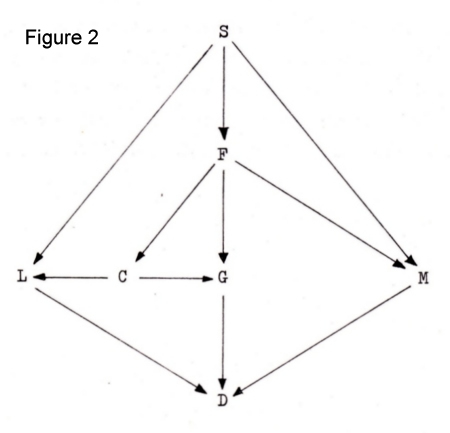
| 1 Speech situation | S |
| 2 Language function | F |
| 3 Conceptual categories | C |
| 4 Lexical elements | L |
| 5 Grammatical rules | G |
| 6 Medium-conversion vector | M |
| 7 Delta-Diagram | D |
------------------------------------------------- page 11 ------------------------------------------------
A target standard should be assigned to each module. The precise way in which this is to be done is still uncertain and depends on testing techniques and the scales associated with them. Trim 1973a, p 15, lists six aspects of performance to which different target standards should be assigned:"
|
Some of these are in fact complex components and can be broken down into more elementary components. I shall not attempt to do this here but confine myself to some more basic remarks about the importance of the target standard in a system for the specification of objectives.
If the objectives are set up to aid examination authorities, it is not necessary for the concept of 'target standard' to be used, even though this concept does occur in traditional examinations where it is represented by the minimum standard required for a pass. However, different standards in the same aspect of the same skill may be acceptable for different tasks in language use and the idea of a simple pass / fail distinction is therefore rather unsubtle as compared to examinations which simply certify that a certain standard, high or low, has been reached in a specific aspect of a specific skill and which leave it to the learner or an employer to decide whether they are satisfied with that standard or whether the learner should continue his studies to reach a higher standard.
However, if the system is to serve course designers, the indication of a target standard is necessary and the requirements of the *** speech situation *** in which the skill is to be used have to be taken into consideration in determining it. Course designers need an indication of target standard in order to determine the thoroughness (including the number of repetitions) with which they treat a certain skill and in order to determine what
------------------------------------------------- page 12 ------------------------------------------------
kind of directions they have to give to the learner for his independent learning with the course material, e.g. when may he stop work on an exercise in the language laboratory, when and how often should he revise it (cf Bung 1972a). If the external specification of objectives does not contain a target standard, the course designer himself will explicitly or implicitly set himself a target standard to aim at.
The structural and semantic relationship between Trim's components of 'target standard' and the other components of a module specification ('subject matter') is still uncertain. Is 'target standard' an eighth component of the module specification, having the same rank as the subject matter components? Or is a module to be regarded as consisting of two components, the first of which is the subject matter specified terms of the seven subcomponents 'Speech situation, Language function, ..., Delta-Diagram' and the second of which is the 'target standard' with all its subcomponents? Or are we to assign one or several of the subcomponents of target standard to some (but not all) subcomponents of subject matter (e.g. Figure 3).
Figure 3
| Subject matter components | Relevant target standard components |
| speech situation | appropriateness of language use ... |
| language function | richness of expression ... |
| conceptual categories | |
| MC-vector | none |
| grammatical rules | grammatical correctness |
| lexical elements | correct choice... of vocabulary; correctness of spelling... |
| fluency | |
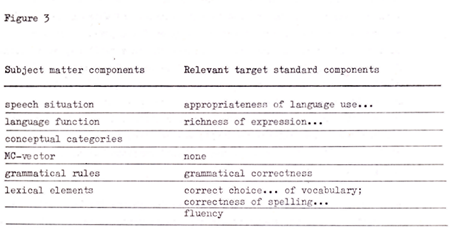
------------------------------------------------- page 13 ------------------------------------------------
The problem of the independence (or otherwise) of subject matter and target standard has been open for some time, in connection with the development of Helmar Frank's didactic variables (see Bung 1972b, where further literature, also in English, is cited) and has also been raised by Milos Lansky (FEOLL, Paderborn) (personal communication). Its solution requires some major effort.
In trying to design a liberal and efficient language learning system, we are concerned with two problems:
1. the selection of skills to be acquired
2. the ordering of skills to be acquired.
I shall begin by discussing principles of ordering skills,
The skilled behaviour of a person who has mastered a foreign language or part of a foreign language can be viewed as consisting of a large number of partial skills. Such partial skills are, for example:
------------------------------------------------- page 14 ------------------------------------------------
We may regard language learning as a step-by-step acquisition of such part-skills. The question arises whether the order in which such skills are acquired affects the speed and ease with which they are acquired. Common pedagogical practice suggests that, regardless of the type of learner concerned, certain sequences of skills are learnt more easily than others.
Example 1
It is likely to be easier for learners of English to acquire the skill of forming questions or negative assertions, if they have first learnt the skill of forming positive assertions.
Example 2
It is likely to be easier for learners of German to acquire the skill of expressing German plural nouns if they have first acquired the skill of expressing German singular nouns, since the plural can often be derived from singular by simple rules but the reverse is not so often the case.
We therefore say that there exists, among some skills of any given language, a GENERAL RELATION OF RECOMMENDED PRECEDENCE.
All relations can be depicted by means of graphs. Let us denote some of the part-skills in the learning of English as follows:
Q the ability to form questions
N the ability to form negative assertions
A the ability to form positive assertions
Then A → Q
says: 'A should precede Q', i.e. 'A should to learnt before Q'.
------------------------------------------------- page 15 ------------------------------------------------
The complete example can be depicted as follows:
Figure 4
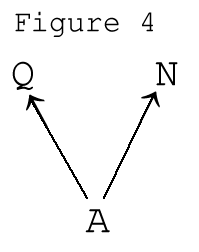 It can be seen that the arrows group the skills into pairs. These pairs are the elements of the relation.
It can be seen that the arrows group the skills into pairs. These pairs are the elements of the relation.
In some relations, each skill is connected to each other skill by means of an arrow. In the English example this is not the case. Neither is there an arrow leading from Q to N nor is there an arrow leading from N to Q.
This means that, from purely linguistic considerations, there is no serious reason why one sequence should be regarded as more efficient than its opposite. In such a case, the learner, teacher or course writer can choose any sequence he likes without necessarily making learning less efficient.
A relation as that shown in Figure 4 is called a 'partial order'. Loosely speaking, the order is 'partial' because a precedence is recommended only for some pairs of skills but not for others. (For a definition of 'partial order', see Abian 1965 and Harary et al. 1965).
If skills are displayed in a syllabus (specification of objectives) in the form of a partial order, the freedom of choice for the learner and teacher is maximised (Bung 1971b). For most partial orders, there are several simple orders which are compatible with it.
------------------------------------------------- page 16 ------------------------------------------------
For instance, the partial order of Figure 4 is compatible with the following simple orders:
Figure 5
A → Q → N
A → N → Q
An example of a GENERAL RELATION OF RECOMMENDED PRECEDENCE is the Delta-Diagram (see Section 2 above).
The first step in setting up a liberal and efficient learning system is the extensive analysis of pairs of language skills in order to ascertain whether or not one should precede the other. A relation of the type discussed will then be set up.
This relation varies from language to language. For any given language, however, the only factors taken into consideration are those inherent in the language itself whereas the varying requirements of specific learners are, for the time being, disregarded. It is for this reason that we call this relation a GENERAL relation (of recommended precedence),
The assertion that a given skill (or set of rules), A, must be taught before another skill (or set of rules), B, is sometimes challenged with the assertion that anything can be learnt in any order. A sentence containing a subjunctive form can occur in the first lesson of a French course and can be successfully used thereafter even though, at that stage, not all forms of the present indicative of regular verbs have been learnt, the semantic significance of the subjunctive has not been discussed, the term subjunctive has not been used, &c. This kind of challenge to the existence of a general relation of recommended precedence
------------------------------------------------- page 17 ------------------------------------------------
can be generalised by asserting that reasons for recommending precedence among skills often disappear when the subject matter analysis changes from a comparatively low level of resolution Klír and Valach 1967 (Klir and Valach 1967) to a higher level of resolution. It is already customary to eliminate logical circularity by shifting the level of resolution in this way, and it is conceivable that, through increasing fragmentation of the subject matter (from general categories such as 'indirect object' to extreme instances such as specific phrases incorporating an indirect object) the general relation of recommended precedence can be abolished.
Let us introduce the notation 'a → b' to represent a case where there are linguistic grounds which demand that skill "a" be learnt before skill "b".
Figure 6
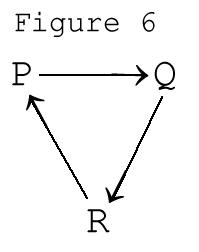 This implies that it is virtually impossible to learn the skills in question. Since practical experience shows that these skills can in fact be learnt, the fault must be with the analysis.
This implies that it is virtually impossible to learn the skills in question. Since practical experience shows that these skills can in fact be learnt, the fault must be with the analysis.
If P = (k, i, j) and Q = (l, m, n), then Figure 6 above asserts, implicitly, the relation of the Figure 7
------------------------------------------------- page 18 ------------------------------------------------
Figure 7
| k → l | i → l | j → l |
| k → m | i → m | j → m |
| k → n | i → n | i → n |
Closer inspection of P, Q and R and of the reasons for setting up the relation of Figure 6 may then reveal that the relation of Figure 7 sets up a number of unnecessary constraints, not due to the inherent structure of the language but to the, perhaps arbitrary, grouping together of k, i and j under the heading of P, &c.
At a higher level of resolution, the relation of Figure 8 may, for instance, be found.
Figure 8
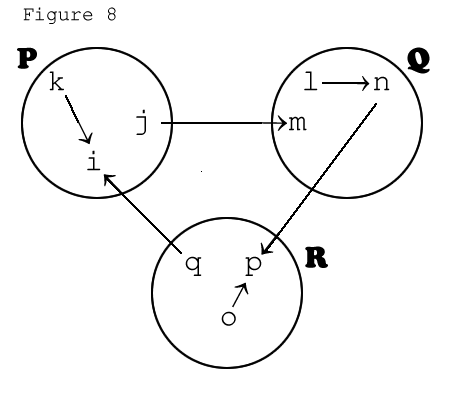
------------------------------------------------- page 19 ------------------------------------------------
If we now re-group the elements of P, Q and R, the original arrows between P, Q and R disappear, such as in Figure 9, where the new higher order categories S, T and U have been set up. No precedence can be recommended among S, T and U.
Figure 9
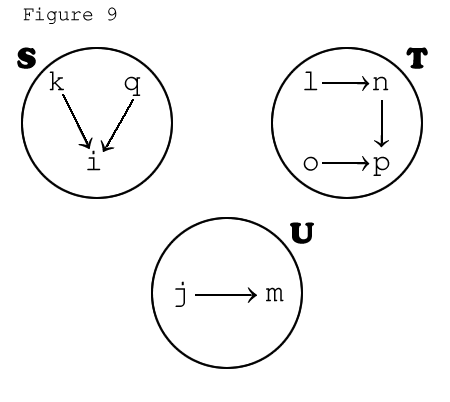
It is possible that in this manner not only arrows in logical circles can be deleted but also arrows in non-circular relations. Whether this is so, remains to be seen.
Obviously, the abolition of the *** relation of recommended precedence *** will greatly increase the freedom of the learner and teacher. However, it may turn out that the fragmentation of subject matter and the frequent switching from one type of structure to quite a different type of
------------------------------------------------- page 20 ------------------------------------------------
structure which may result from the abolition of the larger categories organised in the GENERAL RELATION, will make it difficult for learners to generalise from the examples and sub-rules they are learning and thus obstruct the learning process.
I believe that general recommendations concerning precedence can be made and defended. Since, moreover, the largest possible group of learners, namely all learners, and everybody constructing courses for them or for their constituent subgroups can benefit from a document specifying the general relation of recommended precedence, the preparation of such a document for various languages should have high priority in the development of the UC-system. Note that examination authorities are less likely to benefit from such a document.
If, on the other hand, it is decided that the general relation of recommended precedence is not worth investigating and if, at the same time, it is argued that, below the 'T-level' boundary, no different learners' needs should be distinguished, then no further work remains to be done below the T-level boundary (except for possibly revising van Ek's 1972 inventory cf the subject matter below that boundary); and then the UC-system, below the T-level boundary, cannot make any effective contribution to increasing the learner's freedom to choose his own learning sequences.
When we design the general relation of *** recommended *** precedence, we may come across pairs of skills which are even more strongly linked in respect of the precedence they require. It may turn out that there is a skill, S, and another skill, R, whose relationship is such that S *** cannot possibly *** be learnt and properly executed unless R has previously been learnt. If this type of precedence is broken and a learner tackles S before R, mistakes in S will inevitably result and these mistakes would not be due to forgetting, lack of practice or bad understanding of S but would be due to the missing foundation in R. In such a case, S will only be learnt once the learner has moved on to R and then again proceeded to S. In such a process the learner may sometimes vaccilate between R and S, i.e. execute the sequence SRSRSRSRSRSRSRSRSRS.
------------------------------------------------- page 21 ------------------------------------------------
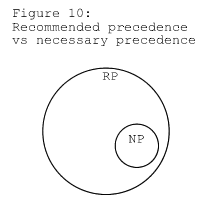 Figure 10
Figure 10
This kind of relation is a SPECIAL CASE of the GENERAL RELATION OF RECOMMENDED PRECEDENCE. We call it the GENERAL RELATION OF NECESSARY PRECEDENCE. Whether such a relation exists in the field of language learning is a question that requires further research.
Note that any relation of necessary precedence (NP) is also a relation of recommended precedence (RP) but not vice versa (Figure 10).
------------------------------------------------- page 22 ------------------------------------------------
I now come to my second point, the consideration of learners who learn for fun, for social reasons or for a variety of reasons with divergent linguistic requirements. An enquiry conducted by Richterich (unpublished) among the students of the Eurocentres in Switzerland shows that such students form the major part of the population investigated (personal communication from Richterich).
Any provision made for language learning on a general scale must therefore, at least, make provision for such learners. How do they benefit from an analysis of this kind? Let us assume that they have arrived in the country of the language which they want to learn without ever having learnt the language at home. Let us also assume that they are equipped (privately, in a school, or through a private teacher with exercises and explanatory materials which help them to acquire the skills contained in the complete GENERAL RELATION OF RECOMMENDED PRECEDENCE.
The diverse and unpredictable needs of such learners are dictated by their environment and the way in which they wish to interact with that environment. They cannot first learn the whole language before putting it into practice in earnest in situations where the results matter (unlike in the classroom). They must use the language while they are learning it.
Assume that the learner has acquired the more primitive skills of asking for accommodation, asking for food and asking for directions (How do I get to ...?). He may now move into an environment where he has a strong need to discuss his work or his hobbies. He may wish to make requests in a more subtle way than was hitherto possible for him (for this he may need skill in using the subjunctive). He may wish to make hypothetical statements, i.e. to say that he would do certain things if only he could, would have done such things, if he had been able to (for this he may need the skill of using the potential form and the imperfect subjunctive).
It would be quite wrong, to say that such requirements are too advanced and that he should first learn the more basic things generally taught
------------------------------------------------- page 23 ------------------------------------------------
at the beginning of text books. The needs of this learner may be very urgent and important. Without such skills, he may not be able to project his personality in such a way as to establish a desired relationship with a potential girlfriend. For him, quite unpredictably, skills which involve mastery of certain subjunctive and potential forms may be more important than others relying only on so-called basic vocabulary or so-called basic structures.
The point at issue for this learner is whether or not he can proceed from his present skills to the skills he wishes so urgently to acquire or how he can reach the desired skills with the smallest effort, i.e. as quickly as possible. The GENERAL RELATION OF RECOMMENDED PRECEDENCE will show him the shortest path to the target which he himself has chosen.
The implications of any claim that there is no general relation of recommended precedence should be considered here. If no attempt is made to specify such a relation (on the grounds that the attempt is unlikely to be successful), then the benefit for non-specialised learners which I have just mentioned could not be provided. The only thing the unit-credit system could offer them would be the concept and the specification of a threshold level (van Ek 1972) and, possibly, some associated tests / examinations / certificates. Note that the specification of a threshold level (T-level) is by its very nature an attempt to set up a general relation of recommended precedence, albeit a very arbitrary one and one which contains a huge number of unnecessary restrictions in the learner's freedom of movement, due to the fact that the chunk of subject matter (e.g. that specified by van Ek 1972) is so very large. If the subject matter assigned to the area below the T-level boundary is called A and all other language skills are called B, then a general relation of recommended precedence, A → B, has been set up.
------------------------------------------------- page 24 ------------------------------------------------
We now turn to the considerations of learners with largely predictable needs, such as the waiter (cf Bung 1973b and c).
We provide for such learners by selecting some of the skills contained in the GENERAL RELATION OF RECOMMENDED PRECEDENCE and by imposing a learner-specific order of precedence on some of the skills which have not yet been ordered in the *** general *** relation of recommended precedence.
Before discussing how the general relation is affected by this process, I want to discuss some of the principles which determine the process of selection and ordering. These principles have been discussed in greater detail in Bung 1973c (Section 4.4).
To start with, we observe closely the prospective learner at work. We disect his process of work into small operations. We observe and describe the linguistic skills associated with each operation. In some countries, no language may be associated with certain operations, e.g. when the waiter puts the dishes on the table. The language associated with other operations may be dispensible.
In the case of the waiter, we find that certain words are unlikely to occur in the execution of his duty and we may find that certain sentence types are seldom, if ever, required. Such words and sentence types are then deleted from the GENERAL RELATION OF RECOMNDED PRECEDENCE. The result is a *** reduced *** GENERAL RELATION OF RECOMMENDED PRECEDENCE.
For different groups of learners different reduced relations will be obtained. These relations will often overlap with one another.
------------------------------------------------- page 25 ------------------------------------------------
Figure 11: Drawing as in printed version of 1973
Note: In this graph, the positions of the vertices (representing skills) are arbitrary.
Figure 11 redrawn on 2010-04-24
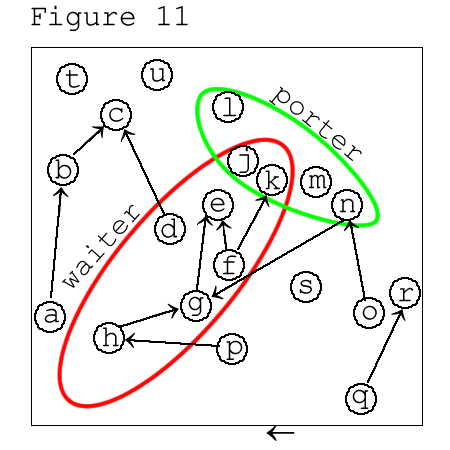
Note added on 2010-04-24:
In this graph, the positions of the vertices (representing skills) are arbitrary. The nodes (vertices) and their connections (arrows) are exactly the same as in the original drawing, but I have assigned letters to the nodes to make it easier to discuss their role in the drawing. -- end of this note
We now ask about each operation (e.g. of the waiter)
We may consider the learning of those skills as most important which are associated with operations that cannot be carried out without the use of language.
Instead we may wish to give priority to the learning of skills associated with the most important operations.
Or we may wish to give priority to the learning of those linguistic skills which take the least time to learn.
------------------------------------------------- page 26 ------------------------------------------------
Most likely all three, and perhaps more, factors are to be taken in consideration. In this case, they have to be weighted and reconciled with each other, since they often indicate incompatible orders.
In any case, the priorities chosen on the basis of such criteria are priorities based on the needs of specific learners. By entering these priorities into the graph of the *** REDUCED *** GENERAL RELATION OF RECOMMENDED PRECEDENCE, we obtain the LEARNER-SPECIFIC RELATION OF RECOMMENDED PRECEDENCE.
The learner-specific relation must be compatible with the general relation, i.e. no matter what the priorities of the learner's need suggest, none of the arrows in the general relation should be reversed. The only change that may be made is that arrows may be entered between skills that were previously not connected by arrows.
In the case of the waiter, the consideration of his needs (Bung 1973c) leads to the conclusion that it is advantageous if he learns the generic food terms (G) before the specific food terms (S).
The general relation of precedence would not contain an arrow between G and S in whatever direction since, from the linguistic point of view, it is irrelevant in which order these vocabularies are learnt. The waiter-specific relation is given by the arrow:
G ----→ S
Example:
If the general relation is as in Figure 12 below and the priorities based only on the learner's needs are as in Figure 13, then the learner-specific relation of recommended precedence is as in Figure 14.
------------------------------------------------- page 27 ------------------------------------------------
Figure 12: General relation
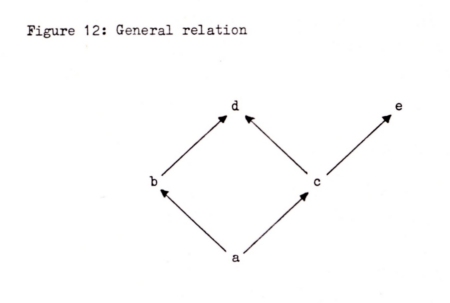
Figure 13: Priorities of learner's needs
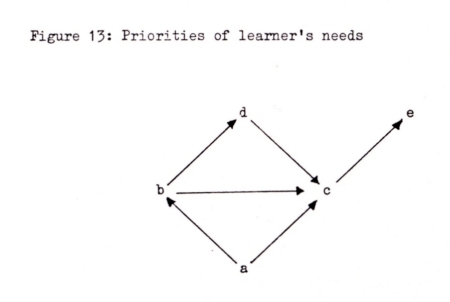
Figure 14: Learner-specific relation
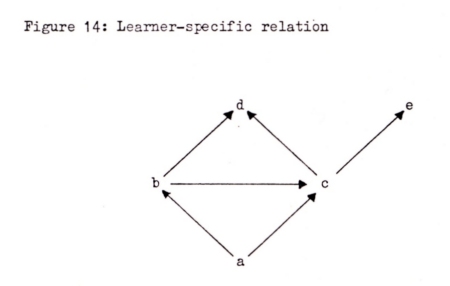
------------------------------------------------- page 28 ------------------------------------------------
The effect of the arrow b → c in Figure 14 is that the learner is now strongly dissuaded from moving straight from a to c without first having learnt b.
Let us assume that we have now a large partial order representing the LEARNER-SPECIFIC RELATION OF RECOMMENDED PRECEDENCE.
It is now up to any learner, teacher or course writer to choose any simple order that is compatible with the learner-specific relation of recommended precedence. The result is the RELATION OF ACTUAL PRECEDENCE. Two such learning sequences are compatible with Figure 14:
a b c e d
a b c d e
It will be noted that the amount of freedom is greatest in the GENERAL RELATION OF RECOMMENDED PRECEDENCE, is less in the LEARNER-SPECIFIC RELATION OF RECOMMENDED PRECEDENCE and is nil in the RELATION OF ACTUAL PRECEDENCE.
An example of the introduction of a constraint (arrow) into the learner-specific relation which is absent in the general relation can be found in the waiter study (Bung 1973c) where it is recommended that the generic food words should be learnt before the specific food words, whereas the general relation would not contain such a precedence recommendation.
An example of the ultimate choice of a simple order out of a recommended partial order can be found in the discussion of correspondence skills in Bung 1973b, p 4.
------------------------------------------------- page 29 ------------------------------------------------
Note that we postulate at most one general relation of recommended precedence but many learner-specific relations of recommended precedence. How many of these should be specified by the Group of Experts?
We may consider several alternative approaches to this problem:
1 It will be impossible to set up specific relations for all groups of learners with a very narrow range of interests. If some such groups are particularly important, relations can be set up for them ad hoc and other groups be neglected. When setting up these relations it is important not to become too narrowly concerned with the final specification aimed at but to develop general procedures which can be used by organisations other than the Council of Europe to set up similar specifications for their own, more narrow, interests.
2 One may investigate whether there are hierarchies of learner groups and whether it is possible to specify hierarchies of priority relations for these, where the lower relations in the hierarchy must not reverse arrows in the higher order relations. (This is a compatibility among relations which is analogous to that maintained for the general and the learner-specific relation of recommended precedence.) For instance, assume that the set of all potential language learners can be partitioned in social-type learners, tourist-type, intellectual-type, vocational / industry and vocational / commerce, and assume that this kind of classification be made exhaustively, into a very small number of very large classes. Assume further that each of these classes can be progressively further partitioned, and more and more specialised needs can be progressively taken into consideration. It would then be possible to provide some *** initial *** guidance for *** all *** learners with as little as five or ten studies, concerned with the top nodes of the hierarchy (i.e. with the most comprehensive classes of the hierarchy). Additional studies concerned with progressively lower levels of
------------------------------------------------- page 30 ------------------------------------------------
the hierarchy can then be conducted as time and resources permit. Each of the relations set up at lower levels of the hierarchy would be obtained by observation of the more narrow group of learners and by accordingly deleting items in the immediately superior relation in the hierarchy and by adding arrows which impose further constraints on the freedom of choice.
In setting up any kind of relation, it is inevitable that 'units' of some kind are considered, no matter how they are named. When I said that pairs of language skills have to be compared in order to ascertain whether skill "a" should precede skill "b", or vice versa, or whether neither skill should have priority over the other, "a" and "b" were units (i.e. complexes of more elementary constituent skills). It is a critical feature of any unit that it is delimited, either fairly arbitrarily or in accordance with a precise prescription. The units of the precedence relations which we have discussed can be delimited fairly arbitrarily. Depending on the boundaries drawn to delimit these units, certain consequences result for the system of objectives that we are setting up:
1. Faulty grouping of sub-units into units can lead to logical circularity and block the process of lesson design;
2. Increasing size of unit tends to diminish the learner's freedom of choice;
3. Decreasing size of unit tends to make the analysis and its representation increasingly complex and can make it unmanageable by manual methods. If the expected gain in freedom of choice warrants the cost, computers can be employed to help with such otherwise unmanageable analyses. A decisive reason for my occasional preference for slightly formal methods of discussion and analysis is my wish not to obstruct, at this stage, the potential use of a computer at a later stage.
Logical circularity must be avoided at all cost. In determining the size of a unit of the type under discussion (technically these are called 'elements of the source set of the realisation') a compromise has to be
------------------------------------------------- page 31 ------------------------------------------------
struck between (2) and (3). In the present, initial, stage of our research, I recommend a bias in favour of (2): this will make analytical work comparatively easy while we are still sorting out the many fundamental problems that are besetting our project. Such analytical work with comparatively large units making up the pairs in the relation will in any case not be wasted because it can, in later years, provide the basis for more subtle analyses which allow more freedom of choice for the learner.
Note that any given learner-specific relation is also a unit (formed by partitioning the general relation of recommended precedence).
For learning purposes alone, an analysis into this kind of unit should be sufficient. However, if some kind of acknowledgement is to be given to learners who have acquired certain skills or groups of skills, then larger units of skills have to be delimited to which such acknowledgements can be attached.
It is the declared aim of the scheme under discussion to encourage more people to begin learning a foreign language, by increasing their freedom to choose different learning aims and learning sequences, by making the content of examinations (if any!) more compatible with the learners' observed needs, and by reducing the difficulty of first examinations as much as is necessary to ensure that their skill content can be acquired in a period of time short enough not to be a deterrent for the learner. This period of time can vary dramatically from learner to learner, depending not only on different learners' different prior knowledge (compare an illiterate with someone who has a good grounding in the grammar of his own language) but also on the learners' different ability to *** learn *** (Bung 1972a). Obviously any examination / testing / assessment techniques must be appropriate to the skills they are meant to assess but it is not the aim of the present research to develop any such techniques.
In spite of the declared aim of the present scheme, the amount of freedom that different members of the Working Group want to give to learners varies. The boundary between devices which give 'firm guidance' and
------------------------------------------------- page 32 ------------------------------------------------
those which 'unnecessarily' restrict the freedom of the learner is not easy to draw. I am strongly opposed to any external attempts to restrict the learner's freedom of movement in any way that is not dictated by the subject matter itself or to exert pressure on him to induce him to accept the recommended priorities. If a learner chooses to ignore our recommendations, he will have a good reason to do so, or he will have to pay the price.
In particular, it is unnecessary, if not positively harmful, to insist that examinations be taken in a certain simple or partial order with only the same or less freedom than is permitted by the recommended precedence relation.
It would be similarly harmful to insist on continuous assessment by the teacher or teaching institution, as opposed to examinations which are conducted at larger intervals and are not part of the teaching and learning process. If continuous assessment is offered to some students as a chance to get credits without more formal examinations with which, for personal reasons, they may be unable to cope in spite of having acquired the relevant language skills, then alternative provision must be made for those students who do not want to be dependent, for their learning and their credits, on the idiosyncracies of a particular teacher or a particular teaching institution. For such students, examinations must be provided which permit them to obtain credits without having subjected themselves to a particular teaching course with simultaneous continuous assessment.
Occasionally, the term 'continuous assessment' is used to denote 'continuous ***self***-assessment'. This entirely different concept, well established in the field of programmed instruction, belongs to the techniques of course construction after the specification of objectives and is therefore outside our terms of reference.
Higher-order units can be formed by cutting sets of elements out of the learner-specific relation of recommended precedence (unless this relation has so few elements that the relation as a whole is treated
------------------------------------------------- page 33 ------------------------------------------------
as a unit). By drawing the boundaries of a unit into an existing relation of recommended precedence, a certain amount of coherence can be ensured within the unit. In principle, the unit boundaries (closed curves) can be drawn in almost any way (e.g. Figure 15) except that no chain of priorities must be crossed more than once by the unit boundary. This has happened in Figure 16.
Note added on 2010-04-27: The printed text says: "no chain of priorities must be crossed more than twice by the unit boundary. This has happened in Figure 16." This strikes me as a misprint. The text should read: "more than once". -- end of note
Figure 15: Correct boundary
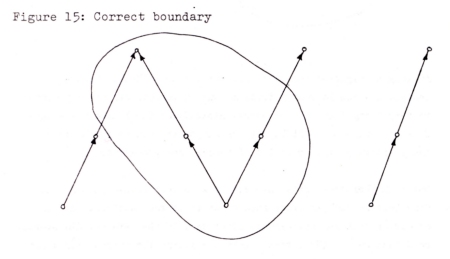
Figure 16: Incorrect boundary
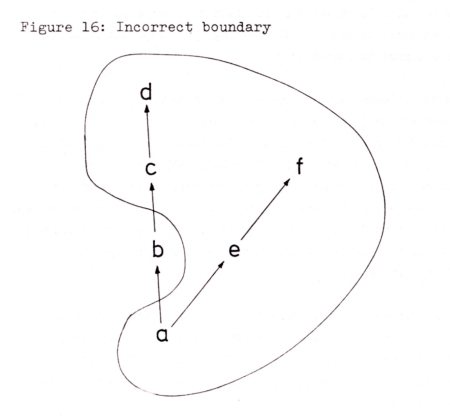
------------------------------------------------- page 34 ------------------------------------------------
The objectionable feature of Figure 16 is that it establishes a circular relation between element "b" (outside the closed curve) and the elements inside the closed curve, which we will call "I". The Figure asserts
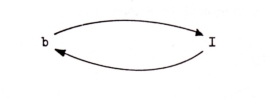
As long as higher-order units are not set up with the purpose of restricting the learners' freedom, such a logical circularity cannot be very harmful but is, at worst, misleading: the learner is always free to ignore the unit boundaries and to proceed on the basis of the learner-specific relation of recommended precedence.
But if higher-order units are set up with restrictive purposes in mind (not so much in examinations but in course construction), the effect of such logical circularities can, if they are not discovered, be disastrous. (Note that, again and again, the purpose for which we wish to set up objectives and units - learning, teaching, or examining - affects the principles which we may have to observe in doing so. It is not adequate to speak of the setting up of explicit objectives: their purpose must be stated too).
Units set up for examination purposes must be large enough for some kind of recognition (e.g. certificate or explicitly declared part of a certificate) to be attached to it. For instance, in the case of a waiter, the 40 van Ek nouns listed in Bung 1973b, p 15 f, may be considered too small a chunk of language to carry recognition but a relevant vocabulary of 170 nouns (even if accompanied by no grammatical skills) may be considered large enough (corresponding to a learning time of, say, 10 to 15 hours). A specimen of such a unit appears in Section 4 of this paper.
Another unit for waiters may overlap with the one just mentioned and may contain a smaller vocabulary, say 40 food nouns, polite phrases (Good morning, Good afternoon, Good evening, Please, Thank you, Can I help you), some verbs and some adjectives (whose identity I have not been
------------------------------------------------- page 35 ------------------------------------------------
able to ascertain because of the lack of a corpus of waiter-utterances). This too may perhaps be accomplished in 10 to 15 hours.
Sets of units may be established where all units share closely related subject matter elements but where these are processed in different modes (and on the basis of different rules). Thus, different units (and thus different marks in one and the same certificate can be attached to, at least, graphic and acoustic skills and to productive and receptive modes and their permissable combinations. An exhaustive enumeration of such distinctions among units may be made with the aid of the medium-conversion model (Bung 1973a).
The superimposition of units onto the learner-specific relation of precedence need not in any way restrict the learner in his freedom of choosing his own learning sequences and benefitting from them in his personal and professional life. It only restricts the freedom of choice of the combination of skills for which he can get public acknowledgement.
Figure 17: Unit A and Unit B
------------------------------------------------- page 36 ------------------------------------------------
Thus it is perfectly feasible for the waiter to acquire the skills of Figure 17 in the order a, d, e, f, ... However, he can only get his public acknowledgement for the acquisition of a, d and e if he has also acquired b and c .
On the other hand there is no reason why he should be required to show a pass in unit A before he is admitted to a test in Unit B. Thus he can acquire competence and a pass in unit B by running through the elements: a, d, e, f, h, g, i, j, k .
The positioning of the T-level is largely arbitrary. We obtain it by drawing a line (not necessarily horizontal and not necessarily straight) through the GENERAL RELATION OF RECOMMENDED PRECEDENCE. The effect will be similar to that of the unit boundaries in Figure 17.
The criteria for drawing such a line are not yet clear. Moreover, we must ask what we would lose if the concept did not exist in the unit-credit system. I will not take up this question now and simply assume that a T-level boundary has somehow been drawn. To what extent does it further restrict the freedom of the learner?
Like the unit-boundaries, it cannot restrict his freedom to choose learning sequences which are compatible with the learner-specific relation of recommended precedence (unless admission to certain courses is made dependent on the passing of certain examinations or teaching materials are constructed in an unnecessarily restrictive fashion). Moreover I feel that a learner should be allowed to be examined in a unit that lies above the T-level boundary even if he has not yet passed any examination in units below that boundary.
This procedure would, in accordance with our general wish, maximise the freedom of the learner.
------------------------------------------------- page 37 ------------------------------------------------
Figure 18
Click on the image to make it larger.
------------------------------------------------- page 38 ------------------------------------------------
Figure 18 represents the characteristic form of the general precedence relation with a T-level boundary drawn in. Certain technical vocabularies have been placed above the T-level boundary. It is evident that, in principle, a learner can start above the T-level boundary provided the necessary teaching materials or informants are available. Similarly a course could start with material situated above the T-level boundary unless external steps (not necessarily commendable) are taken to discourage such courses.
There are two basic alternative approaches for the treatment of special purpose languages:
1. The T-level boundary is drawn in such a way that all material that is of no interest to the learner below the T-level boundary appears above the boundary. In that case, the so-called common core (the subject matter that is considered to be important for all learners at a certain stage of development) is, below the T-level boundary, identical with the T-level content itself. This approach makes for a simple system. Yet it does not imply that no provision for special purpose learners can be made below the T-level boundary. Such provision can be made by assigning to each type of learner or each learner need worthy of special consideration a subset of the total subject matter positioned below the T-level boundary. For the waiter's needs this has been done in the vocabulary part of a specimen unit which is intended to be as rich as possible and yet remain below the T-level boundary as drawn by van Ek 1972 (see Figure 18). This specimen appears in Section 4 of this paper.
2. Alternatively, the T-level boundary must be drawn differently for different groups of learners. Thus, for the waiter but not for the taxi driver, the specific food words such as
will be positioned below the T-level boundary (thus introducing a distinction between common-core and special elements below the T-level boundary).
------------------------------------------------- page 39 ------------------------------------------------
Note written on 2010-04-25: The papers by Klaus Bung referred to below will be republished in print by the end of 2010. Prior to this they will appear on this website, one by one, as time permits. It is therefore worth checking this site, say, once every fortnight to see if any more of these papers have been added. Landa 1968 will also be republished first on this site and later in print. -- end of this note
Abian, Alexander 1965: 'Theory of sets and transfinite arithmetic'. Saunders, Philadelphia, USA .
Bung, Klaus 1966: 'Aufgaben eines Sprachlernzentrums and Vorschläge zu seiner Gestaltung' (Functions of a language learning centre and suggestions for its design). In: Helmar Frank (ed): 'Lehrmaschinen in kybernetischer and pädagogischer Sicht 4', p 282-301. Ernst Klett Verlag, Stuttgart, West Germany. (English translation in Bung 1967)
Bung, Klaus 1967: 'Programmed learning and the language laboratory 2'. Collected papers. Longmac, Victoria Hall, London SE10-ORF, England
Bung, Klaus (ed) 1968: 'Programmed learning and the language laboratory 1'. Collected papers. Longmac, Victoria Hall, London SE10-ORF, England.
Bung, Klaus 1969a: 'Prior knowledge analysis for programmed language instruction'. In: RECALL: REVIEW OF EDUCATIONAL CYBERNETICS AND APPLIED LINGUISTICS, Vol 1, No 3, p 98-117. Longmac, Victoria Hall, London SE10-ORF, England.
Bung, Klaus 1969b: 'The function of the teacher in programmed language instruction'. In: RECALL: REVIEW OF EDUCATIONAL CYBERNETICS AND APPLIED LINGUISTICS, Vol 1, No 2, 1969, p 55-78. Longmac, Victoria Hall, London SE10-ORF, England.
Bung, Klaus 1969c: 'Towards truly programmed language laboratory courses'. In: AUDIO-VISUAL LANGUAGE JOURNAL, Vol 7, p 5-17. London, England.
Bung, Klaus 1970: 'Arbeiten zum programmierten Sprachunterricht' (Papers on programmed language instruction). Vol 1: 'Probleme der Aufgabenanalyse bei der Erstellung von Sprachprogrammen' (Problems of task analysis for the construction of language programmes). Julius Groos Verlag, Heidelberg, West Germany
Bung, Klaus 1971a: 'A cybernetic approach to programmed language instruction'. In: EDUCATIONAL MEDIA INTERNATIONAL, 1971, No 4, p 24-31. International Council for Educational Media, The Modino Press Ltd, 68 Queen Street, London EC4N-1AL, England
Bung, Klaus 1971b: 'The concept of partial order in programmed language instruction and the freedom of the consumer'. In: PROGRAMMED LEARNING AND EDUCATIONAL TECHNOLOGY, Vol 8, p 22-33 and p 122-124. Sweet and Maxwell, London, England
------------------------------------------------- page 40 ------------------------------------------------
Bung, Klaus 1972a: 'Teaching algorithms and learning algorithms'. Mimeographed. To be published in Klaus Bung: 'The technology of foreign language instruction. Collected papers.' Longmac, Victoria Hall, London SE10-ORF, England. 1973
Bung, Klaus 1972b: 'Zur Neugestaltung von Helmar Franks didaktischen Variablen' (The re-design of Helmar Frank's didactic variables). To be published in: Klaus Weltner (ed): 'Proceedings of "Lehrsysteme 72 Berlin"'. Ehrenwirth Verlag, Munich, West Germany
Bung, Klaus 1973a: 'The input-output relation in language behaviour'. Council of Europe, CCC/EES (73) 12, Strasbourg, France
Bung, Klaus 1973b: 'The foreign language needs of waiters and hotel staff'. Council of Europe, CCC/EES (73) 16, Strasbourg, France (Shortened version (19 pp) of Bung 1973c)
Bung, Klaus 1973c: 'The foreign language needs of waiters and hotel staff'. 117 pp. To be published in 'The technology of foreign language instruction. Collected papers by Klaus Bung'. Longmac, Victoria Hall, London SE10 ORF, England
Bung, Klaus 1973d: 'Towards a theory of foreign language instruction'. JANUA LINGUARUM, Series Didactica 1, Mouton, The Hague, Holland
Bung, Klaus 1974: 'A theoretical model for programmed language instruction'. To be published by Mouton, The Hague, Holland
Harary, Frank, R Z Norman and D Cartwright 1965: 'Structural models: an introduction to the theory of directed graphs'. John Wiley, New York, USA
Klir, Jiri, and M Valach 1967 (Jiři Klír / Jiri Klir and M Valach): 'Cybernetic modelling'. Iliffe Books, London, England
Landa, Lev N 1968; 'Algorithms and programmed instruction'. In: Bung 1968, p 57-135
Landa, Lev N 1969: 'Algorithmierung im Unterricht' (Algorithms in the school). Volk and Wissen VE Verlag, Berlin (Original Russian edition 'Algorimisacija v obucenij', Moscow, 1966. Spanish translation published in 1972 or 1973. English translation (USA) in preparation)
Lariccia, Giovanni, and Piergiorgio Gherardini 1971 and 1972: 'Algoritmi e istruzione programmata' (Algorithms and programmed instruction). In: BOLLETTINO, Vol 2, No 1, and Vol 3, No 3, Centro Nazionale Italiano Tecnologie Educative, Via Marche 84, Rome, Italy
------------------------------------------------- page 41 ------------------------------------------------
Richterich, René 1972: 'A model for the definition of language needs of adults learning a modern language'. Council of Europe, CCC/EES (72) 49, Strasbourg, France
Trim, John L M 1973: 'Draft outline of a European unit-credit system for modern language learning by adults'. Council of Europe, CCC/EES (73) 9. Strasbourg, France
van Ek, J A 1972: 'Proposal for a definition of a threshold level in foreign language learning by adults'. Council of Europe, CCC/EES (72) 72. Strasbourg, France.
Wilkins, David A 1972: 'An investigation into the linguistic and situational content of the common core in a unit-credit system'. Council of Europe, CC/EES (72) 67, Strasbourg, France
(c) 1973 and 2010 Klaus Bung
Here endeth the short version.
Click here to see Section 4 (part of the long version).